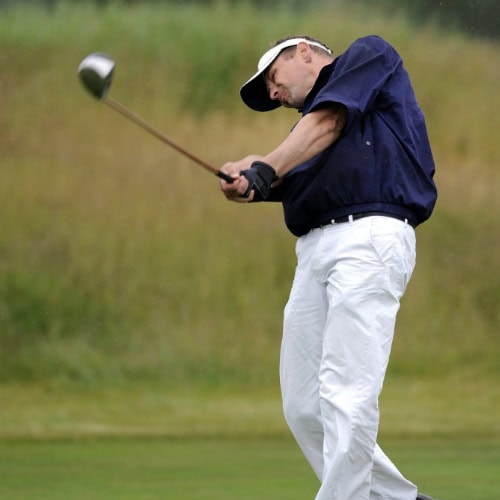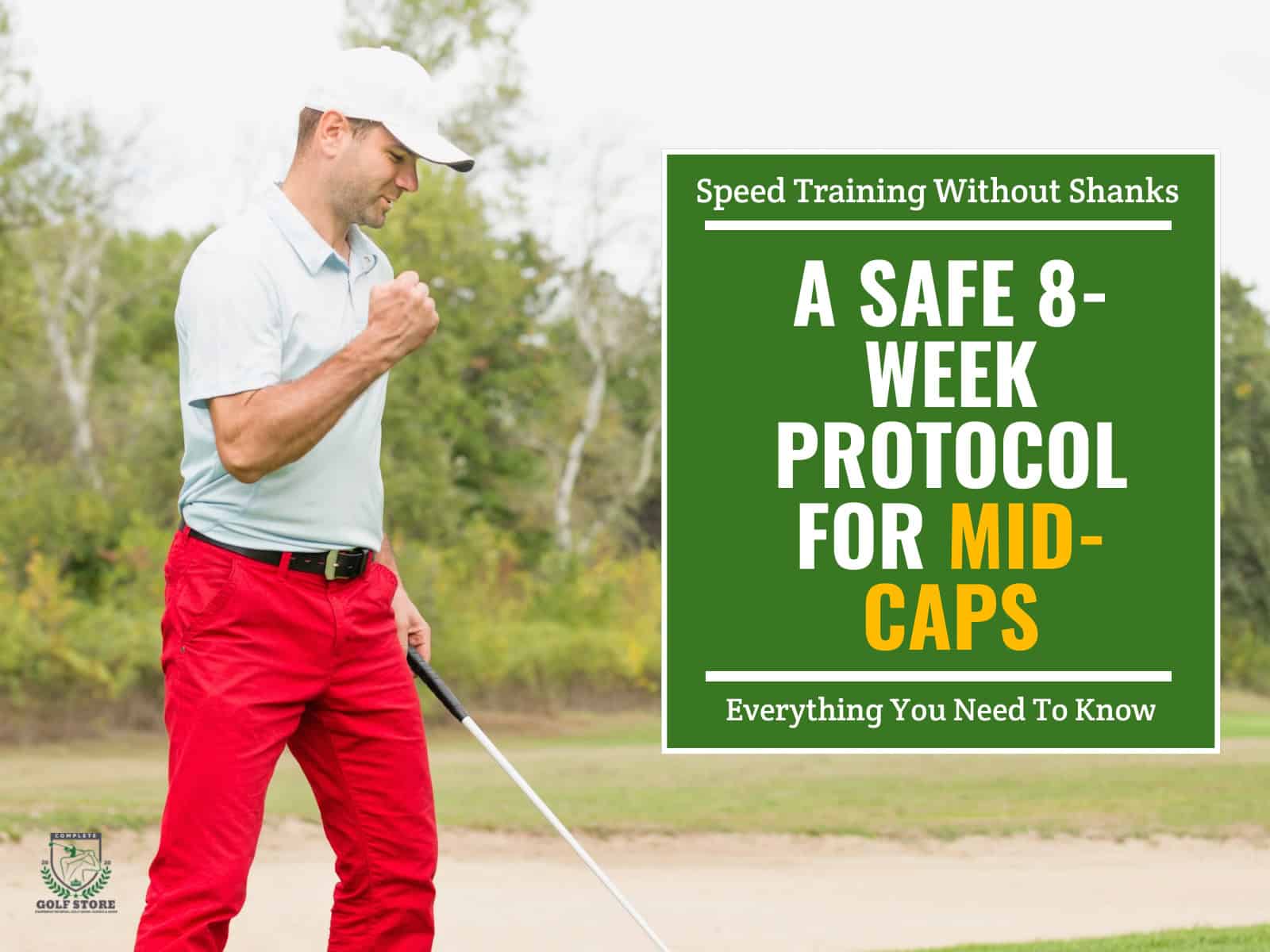We golfers know the first tee can feel like a stage. Your grip tightens, heart races and the swing you owned on the range suddenly feels foreign. That’s when most players slip into “playing golfswing,” drowning in mechanics instead of trusting what they’ve already trained.
Yet nerves don’t have to wreck your round. With the right mental routines: steady breathing, clear visualization, a reliable pre-shot routine, and one simple focus, you can turn adrenaline into fuel.
Here you’ll learn practical ways to handle that pressure, stop overthinking and swing freely when it matters most.
- 1) Why First-Tee Pressure Feels So Overwhelming
- 2) Calm Your Body with Breathing Techniques
- 3) Build a Repeatable Pre-Shot Routine
- 4) Target Visualization and External Focus
- 5) One-Swing Keys That Simplify the Mind
- 6) Acceptance and Mindset Shifts
- 7) Preparation Before the Round
-
8)
Frequently Asked Questions
- 8.1) How can I warm up so I feel confident before the first tee?
- 8.2) What’s the best quick breathing exercise if I only have 10 seconds before hitting?
- 8.3) How do I stop comparing myself to others when everyone is watching?
- 8.4) Can I use the same pre-shot routine for putting and driving?
- 8.5) What should I do if my mind goes blank over the ball?
- 8.6) How do I practice visualization effectively on the range?
- 8.7) Is there a way to reset my confidence if I hit a terrible first tee shot?
- 9) Final Thoughts
Why First-Tee Pressure Feels So Overwhelming
Pressure on the first tee can feel heavier than any other shot of the day. Breaking it down into parts shows why nerves spike and swings fall apart so quickly.
The Spotlight Effect
Step onto the first tee and suddenly it feels like the whole world is watching. Your palms sweat, shoulders tighten and even the driver in your hands feels heavier. This reaction has less to do with your swing and more to do with the spotlight effect: the belief that every eye is glued to you, waiting for you to fail.
Truth is, most people are too busy worrying about their own shot to care about yours.

Fear of Embarrassment
You picture a topped drive or a wild slice. That image of embarrassment can weigh more than the club itself. The mind starts racing, replaying worst-case scenarios, and your body follows by locking up.
It’s like carrying a backpack full of bricks to the tee box; you don’t notice until it drags you down.
Adrenaline’s Impact
Add adrenaline to the mix, and the challenge grows. Your heart rate spikes, muscles fire faster than usual and the swing you trusted on the range now feels rushed.
Tempo disappears, timing slips and what should be a smooth motion turns jerky. Adrenaline is meant to help, but without control, it hijacks rhythm.
Pressure on the first tee isn’t about ability. It’s about perception—how you see yourself and how you think others see you. Once you understand that, the first step toward calm becomes clear. The question is, how do you shift from panic to poise?
Calm Your Body with Breathing Techniques
Your body often reacts before your mind does. Heart racing, hands trembling, breath shallow. If you don’t get control, the swing is doomed before it starts. Breathing is the quickest lever you can pull to settle down.

Deep Belly Breathing
Instead of breathing high in your chest, let air sink low into your stomach. Inhale through your nose for four counts, feel your belly expand, then exhale slowly through your mouth for six. Do it twice.
This type of breath sends a signal: calm down, you’re safe.
Box Breathing and the 4-7-8 Method
For a sharper reset, try box breathing. Inhale for four counts, hold for four, exhale for four, hold for four. Repeat once or twice to steady rhythm.
Another tool is the 4-7-8 method: inhale for four, hold for seven, release for eight. Both slow your heart and smooth your tempo.
Physiological Sigh
Sometimes one quick fix is enough. Take two short inhales through the nose, then a long sigh out the mouth. It dumps tension fast and feels like flipping a switch.
Build a Repeatable Pre-Shot Routine
Every shot begins long before the club meets the ball. A repeatable pre-shot routine gives you control, even when nerves try to steal it. The goal isn’t perfection; it’s comfort and consistency.

Core Elements of a Routine
Start with the basics. Pick your club with purpose, not doubt. Once the club is in hand, choose a clear target. Forget hazards; your mind can’t process negatives. Step behind the ball and take one or two practice swings that mirror what you want to feel. Then walk into your stance, align your body and settle into posture. From there, let the swing flow.
Confidence in your pre-shot routine also depends on setting realistic expectations about distance. A ball speed reality check can help you understand what yardages are truly required to break 90 or 80, so you focus less on forcing distance and more on executing a consistent swing.
Why Routines Work
Routines work because they take thinking out of the equation. When you repeat the same steps every time, pressure has fewer places to creep in. Instead of wondering what could go wrong, you fall back on what you’ve rehearsed. It shifts your focus from results to process, and that’s where confidence lives.
Target Visualization and External Focus
Your swing follows your mind’s picture. If the picture is fuzzy or full of hazards, the swing suffers. A clear target gives the body direction, like an arrow finding its mark.
Visualizing the Shot
Stand behind the ball and imagine the ball flight you want. See it rise, curve and land. Picture the bounce and roll. The more vivid the image, the more your body organizes itself to deliver it.
Quiet Eyes
Once over the ball, keep your eyes locked on the target spot. It could be a tree branch, a patch of fairway or even a leaf. Quiet eyes stop your brain from wandering back into mechanics.
Replacing Negatives
Telling yourself “don’t slice” is like planting the slice in your swing. The brain doesn’t hear “don’t.” Instead, pick a small positive target and commit. Direct the mind where you want the ball to go, not where you fear it might end up.
Golf isn’t always played from a flat lie, and uneven ground can make visualization and commitment even harder. Learning a proper uneven lies golf setup helps you adapt your stance and maintain confidence when facing sidehill, uphill, or downhill shots, ensuring your mental routine holds up in any condition.

One-Swing Keys That Simplify the Mind
When pressure mounts, too many thoughts crowd the brain. Swing mechanics, grip, weight shift—it’s noise. What you need is one clear key that simplifies everything.
Simple Non-Mechanical Cues
The best keys aren’t technical. They’re feels. Saying “smooth tempo” keeps your rhythm steady. Thinking “chest to target” encourages a full turn without breaking it down into parts. Even a word like “flow” can guide the body better than a dozen swing tips.
How One Cue Shapes the Swing
One key works like a compass. It points your mind in one direction so the rest of your body can follow. When the thought is simple, timing improves, balance holds and the swing moves without hesitation.
Avoiding Mental Overload
Stacking multiple keys is a trap. The brain can’t process three or four commands in one second. Choose one, trust it and let the subconscious handle the rest.
Acceptance and Mindset Shifts

Pressure doesn’t vanish, but you can change how you see it. Instead of fighting nerves, treat them as fuel. The same adrenaline that makes your hands shake can also give your swing power if you frame it right.
Reframe Nerves as Excitement
Tell yourself this buzz of energy isn’t fear; it’s excitement. Tiger Woods admitted he always felt nervous on the first tee. If the best in the world felt it, why expect anything different for yourself? The trick is to lean into it, not resist.
Simple Acceptance Scripts
When doubt creeps in, use short phrases that ground you. Say, “embrace it,” or “just swing.” These scripts act like anchors, keeping you from drifting into panic. They don’t erase nerves, but they remind you that you can still play your shot.
Keep Perspective
One swing doesn’t make or break a round. Even a poor drive on the first tee can be followed by a par or birdie. Keep the game in context. Golf is hard, and mistakes are part of it. The less you cling to outcomes, the freer your swing becomes.
Preparation Before the Round
What you do before the first tee matters as much as the shot itself. The right preparation sets the stage for calm and confidence.

Warming Up with Purpose
Don’t rush to the range and spray balls. Start slow, loosen the body and build rhythm. End your warm-up with the club you’ll hit first. That way, your last memory before stepping up matches the shot you need to hit.
Rehearsing Scenarios
Pressure feels lighter when it isn’t new. On the range, picture the first tee: imagine the crowd, the nerves, even the wind. Hit a few shots as if you’re there. When the real moment comes, it feels like a rerun, not a debut.
Grounding Drills
If nerves pull you into your head, anchor yourself. Stand tall, rise up on your toes, then settle your feet back into the ground. Feel the weight shift. This quick drill puts attention in your body, not your worries.
Frequently Asked Questions
Every golfer faces first-tee nerves, and the same challenges come up again and again. That’s why we included questions and answers that give you simple, practical ways to handle them.
How can I warm up so I feel confident before the first tee?
Start slow and build rhythm. Stretch, chip and putt before hitting full swings. End with the club you’ll use on the first tee so the motion feels fresh when it matters.
What’s the best quick breathing exercise if I only have 10 seconds before hitting?
Take one deep belly breath, in through the nose and out through the mouth. If time allows, add a second inhale and a long sigh. It’s fast, simple and resets your body.
How do I stop comparing myself to others when everyone is watching?
Remember the spotlight effect: most golfers are too focused on their own swing to notice yours. Shift your mind to the target, not the people.
Can I use the same pre-shot routine for putting and driving?
Yes. The details differ, but the rhythm should match. A repeatable process builds confidence no matter the club.
What should I do if my mind goes blank over the ball?
Stick to one swing key. A single cue like “smooth tempo” gives the brain direction and prevents freezing.
How do I practice visualization effectively on the range?
Don’t just rake and hit. Stand behind the ball, see the shot in your mind and then swing. Treat practice like play, not just repetition.
Is there a way to reset my confidence if I hit a terrible first tee shot?
Yes. Take a breath, accept the mistake and refocus on the next target. One shot doesn’t define the round, but how you react to it might.
Final Thoughts
The first tee will never stop bringing nerves, but nerves aren’t the enemy. They’re proof you care, and with the right approach, they become fuel. Breathing settles the body, routines anchor the mind and one clear swing key cuts through the noise.
When you trust a target instead of chasing perfect mechanics, your swing gains freedom. When you accept pressure instead of resisting it, your game steadies. Preparation turns jitters into readiness, and perspective keeps one shot from carrying the weight of a round.
Golf rewards those who simplify. Strip away the clutter, lean on your process and let instinct take over. The next time you step onto the first tee, the question won’t be whether you feel nerves; it’ll be how you use them.





